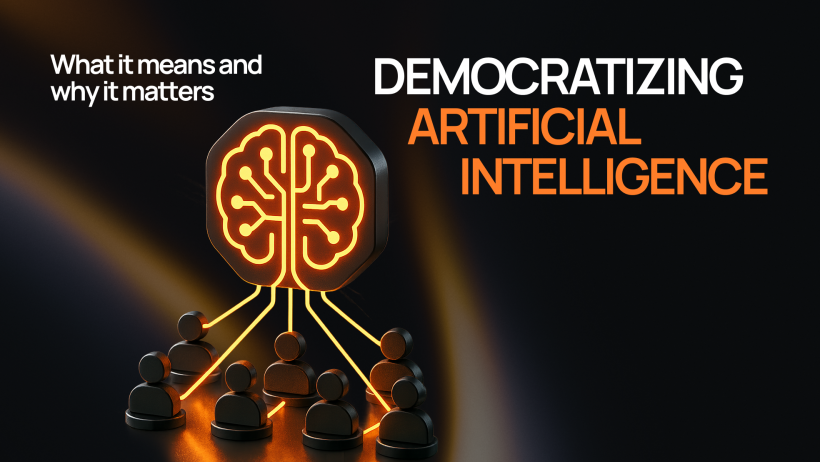According to these statistics, the global AI democratization market is expected to reach $487.7 billion from 2025 to 2034, growing at a CAGR of 32.60% (compared to $29.02 billion in 2024). This clearly highlights the potential of this field, which strives to make AI accessible to a wider audience. Below, we’ll answer the “What is AI democratization?” question, explain the importance of AI democratization from a business perspective, and share our practical insights.
What Is AI Democratization?
So, what does democratizing AI mean? Simply put, it means lowering the entry threshold for AI-powered tools and technologies so that they become accessible and understandable to a wider audience (i.e., not just IT specialists and large tech companies). In practice, this is typically achieved through standardization and simplification of user interfaces, as well as automation of MLOps operations.
Besides accessibility, AI democratization is based on principles such as:
- Decentralization, which implies control over AI development by a wide range of stakeholders;
- Fairness, which eliminates bias in conclusions and guarantees their ethics;
- Transparency, usually ensured through additional human oversight.
For businesses, this means that when hiring specialists from fields unrelated to AI development, they will no longer need to add relevant technical skills to their list of requirements. At the same time, these specialists will be able to use AI solutions through any access channels to models, whether they are APIs, widgets, low-code interfaces, or built-in services.
How Is AI Democratization Happening?

Democratizing AI is the result of technical solutions that make even the most advanced AI-powered tools easy to use and accessible even to individuals. These solutions include the following:
- Availability of ready-made models and platforms. Open repositories and model hubs, such as Hugging Face, provide thousands of ready-made, pre-trained AI models. This means businesses don't have to spend millions of dollars and months developing and training a custom model from scratch.
- Open-source APIs and standardization. Cloud and local APIs eliminate the need to understand how the algorithms that generate AI models work – instead, users simply submit their requests and receive instant responses. Depending on whether the API is cloud-based or local, requests are processed either remotely or directly on the user's device.
- Automation via MLOps. MLOps automation, enabled through versioning, CI/CD, and monitoring, simplifies the process of building, deploying, and subsequently supporting AI models (which, in turn, can also be pre-built by a third-party team).
Ultimately, standardization, open-source libraries, and simple builders significantly reduce the complexity of AI adoption for teams without compromising this technology’s efficiency. If you're interested in the development of a solution based on AI-democratized tools, please write to us or give us a call.
Why Democratizing Artificial Intelligence Matters
Democratization transforms AI from a narrowly focused tool for research teams into a powerful tool for automation, forecasting, analysis, personalization, and other tasks that require processing colossal amounts of data in real time.
In particular, for startups planning to integrate AI into their solutions, AI democratization offers several benefits at once: reduced time-to-market and budget thanks to ready-made templates and AutoML, minimized vendor lock-in through contract standardization and containerization, and ROI transparency, as they gain the ability to quickly calculate critical metrics to assess economic impact.
In applied industries, like education, AI democratization enables the implementation of personalized courses with automatic progress assessment for each student. In the healthcare sector, it can form the basis for triage systems, smart assistants for image interpretation, and patient prioritization. As for agriculture, it can be used to forecast crop yields and optimize resources.
At the same time, regardless of the sector, the development team must include independent validation and audit stages before production. Also, if you’re going to develop an AI-democratized solution from scratch, it's important to use generally accepted approaches to bridging the digital divide, such as quantization, pruning, packaging inference into lightweight containers for edge devices, localizing models and data, training in-house teams, and providing low-code interfaces.
Benefits of Democratizing AI
The democratization of AI offers businesses a number of undeniable advantages, from reduced time-to-production thanks to the availability of reusable components and almost unlimited scalability without the need to constantly expand the development team to ensuring consistently high solution quality through the involvement of subject matter experts during the training and validation phases. This means you'll be less likely to get stuck in the proof-of-concept phase and, instead, more likely to increase the frequency of product releases, all with measurable KPIs and SLOs.
For example, we can build a working prototype based on pre-trained components in just 1-2 sprints, and then proceed to full customization via the MLOps pipeline. Moreover, given the constantly expanding ecosystem of open repositories and ready-made connectors, this further accelerates the transformation of an MVP into a full-fledged AI solution and reduces the cost of its implementation.
Challenges and Risks
The fact that your technical team uses AI-democratized tools to build your solution doesn't negate the complexity of the development process itself – it simply allows them to focus on other tasks, like business logic implementation, UI creation, and so on.
At the same time, development shouldn't overlook maintaining proper data quality, regularly assessing technical debt (most often caused by non-versioned datasets and ad-hoc feature engineering), carefully implementing CI/CD, as well as introducing discipline around owner roles.
In practice, this translates into the need to adhere to a strict MLOps paradigm with data and model versioning, automated quality tests, operational metrics, as well as process accountability.
It's also worth noting potential security and privacy issues – public APIs and a large number of integrations increase the risk of data leaks and attacks, like membership inference, model inversion, and poisoning.
Finally, you always risk using the model incorrectly due to a lack of governance, which can lead to biased conclusions, unethical behavior, and all sorts of legal problems.
Real-World Examples of AI Democratization

The AI democratization in practice can be implemented in various forms, such as:
- Open resources such as model hubs and open-source ecosystems. These include solutions like Hugging Face, which represent colossal online libraries containing thousands of pre-trained AI models. This means that instead of spending months developing an AI model from scratch, you can take a ready-made one (for example, for NLP for working with text and language) and immediately integrate it into your product.
- Lightweight models with knowledge distillation and quantization. These are essentially very powerful and resource-intensive AI models (like MobileNetV3/EfficientNet-Lite), which, if deployed locally, would require very powerful and expensive computers and servers. In turn, through distillation and quantization, they allow developers to extract the most important and useful information with a smaller computational footprint (due to the inherent error margin). This opens the possibility of introducing the most sophisticated AI functionality on edge hardware and smartphones.
- Solutions for quickly launching MVPs via AutoML and cloud APIs. AutoML and cloud APIs are considered user-friendly tools because they accelerate the launch of MVPs (specific examples include Google Cloud AutoML and Vertex AI). This means you'll have the opportunity to quickly test your business idea without significant time and capital investment, and, moreover, without the need to deploy your own complex IT infrastructure.
- Tools from the MLOps stack. This is a set of development tools that typically consists of BentoML, DVC, Weights & Biases, Kubeflow, and MLflow. They are designed to standardize the entire model lifecycle, thereby providing transparent control over each stage. In practice, this guarantees the ease of deploying and maintaining enterprise-level AI models, without any force majeure or reputational risks.
Unsure which group of these AI-democratized tools is right for your project? Feel free to contact us, and we'll help you with consultations, as well as its implementation, deployment, and ongoing support.

FAQ
Why is democratizing AI important for businesses and society?
For businesses, this means accelerated and more cost-effective implementation of AI-powered innovations that help automate routine operations and free up employee resources for more creative tasks. Furthermore, democratization gives even small companies the opportunity to compete with large corporations, as both can use the same technologies.
In terms of societal value, AI democratization ensures the inclusiveness of AI for the general public, thereby simplifying their interaction with technology and facilitating the development of ethical solutions tailored to the needs of various population groups.
Who can benefit from access to AI tools and technologies?
These include organizations of all sizes (from SMBs to large corporations), company employees who aren’t AI specialists, creative workers (here, democratized generative AI can help), researchers, educators, as well as government and humanitarian organizations (they can use AI to predict and monitor global problems).
What are some examples of democratized AI tools or platforms?
Democratized tools can be presented in the form of chatbots (ChatGPT and Google Gemini are specific examples), image generation solutions (such as Midjourney and DALL-E 3), as well as presentation (such as Gamma and Decktopus AI) and video/voice generation tools (Synthesia and ElevenLabs). There are also work and study assistants like Otter AI and Fireflies AI, and full-fledged machine learning platforms like DataRobot and JADBio.
What are the benefits of AI democratization?
The benefits of democratizing artificial intelligence primarily include lowering the entry threshold, ensuring inclusivity, and accelerating regular operations for professionals without experience in AI development.
What skills are needed to use AI effectively in a democratized environment?
In AI-democratized environments, it's important to be able to critically evaluate AI results, understand the fundamentals of what AI is, how this technology processes data, and what its limitations are. The success of utilizing such solutions also depends on the creativity of the users themselves and their ability to approach problems creatively. Finally, it's essential to learn the basics of prompt engineering to formulate the most precise and contextual queries possible.

